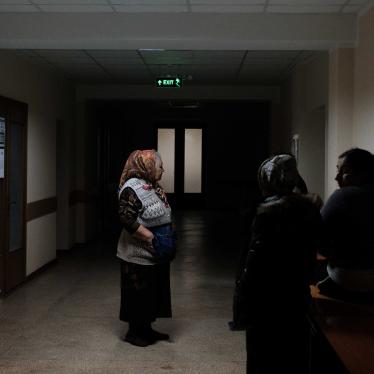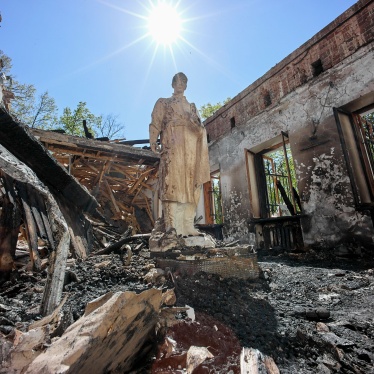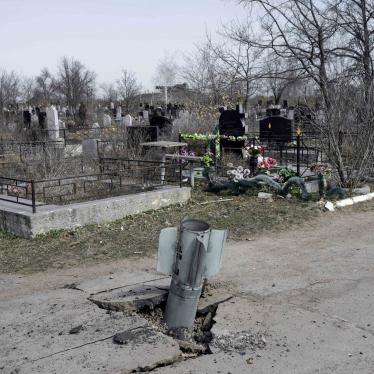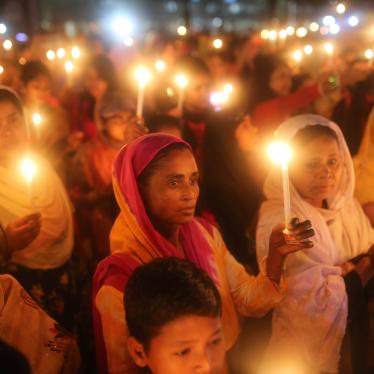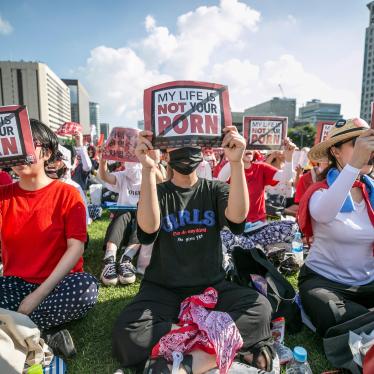Russian forces killed and wounded numerous civilians in eight attacks in Chernihiv city in northeastern Ukraine in early March 2022, Human Rights Watch said today. Four of these attacks, from the air and ground, were in clear violation of the laws of war. They included the bombing of an apartment complex that killed 47 civilians, an attack that killed at least 17 people in a bread line outside a supermarket, and two separate attacks, including one using widely banned cluster munitions, that damaged two hospitals.
Ukrainian forces may have placed civilians at risk in five of the Russian forces’ attacks, including one where Territorial Defense Forces had established a base at a school. One of these Russian strikes hit a hospital, which has enhanced protections under the laws of war, making the strike on the facility unlawful despite the possible presence of a military checkpoint near the hospital. The four other strikes may still have violated prohibitions against indiscriminate or disproportionate attacks, despite the apparent nearby presence of Ukrainian troops.
“Russian forces in March repeatedly attacked populated areas in Chernihiv from the ground and air with seeming disregard for civilian loss of life,” said Belkis Wille, senior crisis and conflict researcher at Human Rights Watch. “The failure of Ukrainian forces in some areas to remove civilians added to the casualties, but the attacker must still distinguish between civilians and combatants.”
The Russian military began attacking Chernihiv on February 24, the first day of Russia’s full-scale invasion of Ukraine. Human Rights Watch investigated attacks on the city that occurred between March 3 and March 17. While Russian forces never captured Chernihiv, by late March they had effectively surrounded the city, trapping civilians and subjecting them to further bombardment. Russian forces withdrew from the area on March 31 as part of their broader retreat from the Kyiv and Chernihiv regions.
Between March 8 and May 9, Human Rights Watch interviewed 34 people including 24 witnesses to the eight attacks, as well as emergency responders, Chernihiv Regional Administration officials, and local prosecutors, who provided civilian casualty figures. On April 19 and 20, researchers inspected the sites of the eight attacks.
Human Rights Watch also reviewed satellite imagery to corroborate the dates and scale of the damage, and to help determine the location of any Ukrainian forces in the vicinity of the attacks. Obituaries of Ukrainian soldiers published in local media also helped to assess whether Ukrainian military personnel were in the vicinity of the attacks.
The Ukrainian Department of Medical Care for the Chernihiv region said that at least 98 civilians were killed in the eight attacks and at least another 123 were wounded. The department’s head said that these numbers were based on reports from local hospitals, emergency medical services, and the official morgue logbook. The official provided Human Rights Watch with the names, ages, and genders of 22 of the people killed and 122 of the people wounded in the attacks. She said forensic experts were still compiling the personal information related to the other casualties and that she would share this with Human Rights Watch when it was complete.
In the deadliest of the eight attacks, Russian forces on March 3 dropped several unguided bombs on an apartment building complex, killing 47 civilians. “When the explosions happened, I saw people falling out of the windows,” a resident of one of the buildings said. “Some of them were on fire.” Several witnesses interviewed said they did not believe that any Ukrainian forces were in the area at the time.
In a March 17 attack on the city center, Russian forces launched an Uragan cluster munition rocket that damaged a medical complex housing two hospitals. Local officials said the attack killed 14 civilians and injured 21 others. Witnesses said they saw no military targets in the area at the time.
Since its invasion of Ukraine, Russian forces have repeatedly used cluster munitions, which are inherently indiscriminate weapons, in attacks that have killed hundreds of civilians and damaged homes, hospitals, and schools. Ukrainian forces appear to have used cluster munitions at least once.
Serious violations of the laws of war, including indiscriminate and disproportionate attacks, committed with criminal intent – that is, deliberately or recklessly – are war crimes. Individuals may also be held criminally liable for attempt to commit a war crime, as well as assisting in, facilitating, aiding, or abetting a war crime. Commanders and civilian leaders may be prosecuted for war crimes as a matter of command responsibility when they knew or should have known about the commission of war crimes and took insufficient measures to prevent them or punish those responsible.
The Russian attacks in Chernihiv demonstrate the devastating impact on civilians and civilian infrastructure when armed forces use explosive weapons with wide-area effects in populated areas, and the increased likelihood of unlawful indiscriminate and disproportionate attacks.
These weapons have a large destructive radius, are inherently inaccurate, or deliver multiple munitions at the same time. Long-term effects of their use include damage to civilian buildings and critical infrastructure, interference with services such as health care and education, and displacement of the local population.
Of the 4,266 civilian deaths and 5,178 civilian injuries that the Office of the United Nations High Commissioner for Human Rights recorded in Ukraine between February 24 and June 7 – most likely a significant undercount – the majority were caused by explosive weapons with wide-area effects, including shelling from heavy artillery and multi-barrel rocket launchers, and missile and airstrikes.
Russia and Ukraine should avoid using explosive weapons with wide-area effects in populated areas, Human Rights Watch said. All countries should support a strong international political declaration to better protect civilians from the use of such weapons in populated areas.
“The Russian forces’ devastating ground and airstrikes on Chernihiv show why explosive weapons should not be used in populated urban settings,” Wille said. “All governments should commit to strengthen protections for civilians from the use of explosive weapons in villages, towns. and cities.”
March 3 Airstrike on Apartment Complex
On March 3 at about 12:15 p.m., Russian aircraft dropped several unguided bombs at an intersection on Chornovola Street in a residential neighborhood in the center of Chernihiv. Local authorities said the attack killed at least 47 civilians and wounded 32. The attack damaged an apartment building and several other residential and commercial buildings, one of which contained a pharmacy.
Human Rights Watch spoke by phone to three witnesses to the attack, including a doctor and two Chernihiv residents. Human Rights Watch also verified and analyzed 22 videos and 12 photographs taken during and just after the attack.
“It was like a windstorm as the whole basement filled up with dust,” the doctor said. “Then there was an explosion. Several windows were blown out, and there was a lot of vibration. We have explosions every day, but this one was very powerful.”
The doctor said that he and his colleagues treated 35 injured people ranging in age from 7 to 55. He said he remembered one boy whose ankle was cut open and a girl who had a metal fragment from the munition in her face. A boy about 12 had metal shards in his brain and damage to the skull, he said.
Human Rights Watch researchers who visited the attack site on April 19 saw at least five distinct impact craters left by munitions. At least one more bomb had hit a nearby 18-story apartment building, seriously damaging floors 12 to 15. The blasts also seriously damaged two nine-story apartment buildings and blew out the windows and seriously damaged the facades of two other nine-story apartment buildings. A pharmacy in one of these buildings was also seriously damaged, as well as a medical center that was not in use at the time.
The area had not come under attack since March 3.
Olena Piatkina, a resident of one of the damaged buildings, said she was in the basement sheltering when one of the bombs struck just meters from her building:
After the explosion, I looked left and saw light coming into the basement. I started crawling out through the rubble. I saw lots of fires outside. As I was getting out of the basement, a man handed me a baby that was covered in blood and asked me to help him get out another three children who were there in an apartment. There was one girl who had been hit in the head and was covered in blood. The children were all in shock and crying.
Based on its interviews and videos, Human Rights Watch found no indications that Ukrainian military forces were deployed in the area at the time of the attack.
The strikes appear indiscriminate, in violation of the laws-of-war prohibition on attacks that are not directed at a specific military objective.
March 3 Attacks on Schools, Houses on Biloruskyi Lane
In three attacks on March 3, Russian bombs hit two schools and several homes on Biloruskyi Lane, all within several hundred meters of each other. Human Rights Watch interviewed eight witnesses to the attacks and observed the damage.
School 18 is a primary and secondary school, but after the Russian invasion the local Territorial Defense Forces established their headquarters there, residents and volunteer aid workers said. At the same time, the school was used as a distribution center for food and other aid.
About 12:30 p.m., an aircraft flying overhead dropped a bomb, a witness said. The munition caused severe damage to one corner of the school, which Human Rights Watch observed during a visit on April 19. At least 150 people were at the school when it was hit, some of them Ukrainian armed forces including from the Territorial Defense Forces, said a witness.
Local officials said that 2 civilians were killed and 14 were wounded in the attack. A photo posted to Facebook on March 4 from the school, shows two bodies covered in plastic sheets.
Either shortly before or after the attack on School 18, the aircraft dropped a bomb on School 21, 250 meters away. A high school student said that he was in the yard of his home, about 100 meters from the school, when he “heard a whistle, and then a big explosion.”
At the time of the attack, about 200 civilians were sheltering in the school basement because their homes did not have basements, the student said. A man living near School 21 said Territorial Defense Forces had set up a military post with sandbags in front of the school at the intersection with Biloruskyi Lane. One woman said she saw the body of a Territorial Defense Force member lying on the sandbags after the attack.
Volunteer workers were on the ground floor and first floor of School 21, gathering clothing and other items for the Territorial Defense Forces and cooking for them and armed forces personnel. The student said that there may have been some soldiers coming in and out of the school to pick up food and aid, and he saw armed men driving in civilian cars. A man living near the school said Territorial Defense Forces were also sleeping in the school.
The strike on School 21 destroyed much of the building. Local officials said 3 civilians were killed and 19 others were wounded. The people killed and wounded were on the ground floor, the first floor, or in the yard at the time of the attack, the student said.
One of the wounded survivors posted an Instagram story on March 3, since reposted on Twitter, in which she describes the attack.
The local news site Suspilne Media posted six obituaries for members of the Territorial Defense Forces who died in the attacks on School 18, School 21, and Biloruskyi Lane, indicating the military presence.
Just after the two schools were hit, at least two more apparent bombs struck a cluster of houses on Biloruskyi Lane, about 150 meters from School 21, leaving two large impact craters, destroying at least eight houses, heavily damaging seven more, and damaging the roof of another, killing at least six people. A university student said he and his brother rushed to the destroyed houses after the attack to check on their friends:
Our friends were fine, but we decided to start digging where the other houses had been destroyed, and as we started, we heard voices from under the rubble. We got one woman and her mother out, and her 14-year-old son, but he was dead. We kept digging around the other destroyed houses and dug out another three dead people: the older sister of my former classmate, her boyfriend, and an older man who I think was her father or grandfather.
A woman living close to the houses that were destroyed said one family with many victims was that of Volodymyr Vasylchenko, whose mother-in-law, 86, was killed along with his son-in-law Mykhailo Zheldak, 40, and Zheldak’s daughter Polina, a third-year language student; Zheldak’s son Glib, who was 14 and in seventh grade; and a friend of Polina’s who was staying with the family.
“People were digging through the rubble and there was a voice,” the woman said. “They took out a boy, it was little Glib.... His head was crushed.”
Zheldak’s wife, Svitlana, and her mother and Volodymyr’s wife, Valentyna Vasylchenko, survived the attack and had since left the city, the woman said. The Zheldaks had apparently moved into the Vasylchenko home because they had presumed the area was safer than where they lived, but all were killed except for Svitlana and Valentyna.
Anatolii Vasylchenko, an emergency responder with the State Emergency Service of Ukraine in Chernihiv, said that based on his analysis of the crater sizes, he believed that aircraft had carried out all the attacks in and around the schools. The impact craters and scale of blast damage to structures that Human Rights Watch observed indicate the use of a large air-delivered blast weapon totaling 250 kilograms or greater in weight.
Ukrainian forces failed to protect civilians under their control from the effects of attacks by not removing them from the vicinity of their forces, Human Rights Watch said. Using schools for military purposes is also contrary to the Safe Schools Declaration, which Ukraine signed in 2019.
While the Russian attacks on the Territorial Defense Forces targeted legitimate military objectives, the strikes on nearby homes may have been indiscriminate because they did not appear to have been directed at a specific military target.
March 13 Attack on Myru Avenue Apartment Buildings
On March 13, two munitions struck a nine-story apartment building on Myru Avenue, and four additional munitions left impact craters next to the building. Human Rights Watch inspected the damage and interviewed two witnesses to the attack.
A resident of the building’s fifth floor, who was home at the time, estimated that about half of the roughly 200 families living in the building were there when the attack took place. Emergency workers had to rescue him from his apartment by crane, he said. Researchers saw heavy damage to the building, as well as damage to four newly constructed apartment buildings nearby, none of which were inhabited at the time of the attack.
The head of the Chernihiv Department of Medical Care, Tetiana Lebedeva, said on April 20 that she did not know the number of dead because officials had yet to remove all bodies from the rubble. As of April 28, officials said they had dug out of the rubble and identified six bodies. Two residents told Human Rights Watch that three people – on the third, fourth, and sixth floors, as well as a couple and their three young children living on the ninth floor, the Manko family, were all killed in the attack. One of the two residents said that at least five building residents have been missing since the attack. “My friends used to live on the third and fourth floors – they all died,” one of the residents said. “I used to visit them and now they are all dead. They are lying there under the rubble.”
Lebedeva and the two residents said at least eight people were injured, including the wife of the man killed on the sixth floor, Volodymyr Bolshak, 49.
This was not the first time the building had come under attack; a munition struck the seventh floor around March 7, and another attack had left two small craters in the earth surrounding the building.
A building resident said he thought he had seen Territorial Defense Forces in the basement of the building, and in the basement of one of the newly constructed towers next door at the time of the March 13 attack.
Human Rights Watch reviewed satellite imagery of Myru Avenue, collected before and after the attack, which showed the presence of several roadblocks on March 11 and March 18. One roadblock is in front of the apartment buildings that were damaged in the attack. Several roadblocks are also visible on March 11 about 270 meters south of the apartment buildings, at the intersection of Myru Avenue and Volodymyr Drozd Street.
Satellite imagery recorded on March 18 shows a large deep pit on the other side of Myru Avenue, across from the buildings that were damaged. The purpose of the pit remains unclear, but it might have been used to protect an armored vehicle. The impact craters and damaged buildings visible in the March 18 image are consistent with witness accounts of the attack and what Human Rights Watch saw at the site. Human Rights Watch found no obituaries of Ukrainian armed forces personnel from that time and place.
The lawfulness of the attack will depend in part on whether Territorial Defense Units and military vehicles, all of which are legitimate military targets, were at the site. However, even if Ukrainian forces were deployed near or in the building, the attack would need to discriminate between combatants and civilians, and the expected loss of civilian life could not be disproportionate to the anticipated military gain from the attack. If no military objectives were present at the time, the attack would have been unlawful.
March 16 Attack on Bread Line on Dotsenka Street
On March 16 at around 9 a.m., dozens of people were gathered at a gate in front of a loading dock at a Soyuz supermarket waiting for free bread when a munition struck in front of the line. Ukrainian authorities reported that at least 18 people were killed and another 26 were wounded. Human Rights Watch interviewed four witnesses to the attack, and one who arrived at the site 30 minutes later.
Dominic Serdiuk, 14, said he was waiting in line with other neighborhood residents who had heard that they could get bread:
At first it was quiet and calm, but then suddenly there were bangs, then gray smoke, and then an explosion. People fell to the ground and then something began to stink. I found myself lying on the ground and I looked down and saw a wound and blood on my left knee and another on my right knee. An old lady came over and used a piece of fabric as a bandage to stop bleeding and tied it above my left knee, and a man covered my left knee with some cloth and carried me on his shoulder toward my house. Before we got there, four men came over and lay me on a slab of wood and took me to a school that was being used as a makeshift clinic.
Serdiuk received medical treatment and when interviewed on April 19 was able to walk with a limp. His doctor told him that a fragment of bone in his left knee was missing.
At the time of the attack, another munition hit an apartment building 150 meters away. A building resident said the explosion caused a fire that killed a woman living on the first floor of the building, and another, Oleksandra, 65, living on the fourth floor. Another neighbor, Valentina Zakharovna, 73, died while waiting in the bread line, the resident said.
Human Rights Watch examined the crater that the munition left and markings on the wall caused by the explosion, as well as the remains of the gates, which had numerous holes blown through them from the attack.
All five witnesses said that to their knowledge, no Ukrainian armed forces, including Territorial Defense Forces, were in the area at the time. One supermarket worker said that he had seen soldiers around the loading dock for a few days in late February and early March, but they had left the area days before the attack. On April 19, Human Rights Watch found a Ukrainian military uniform in a corner of the loading dock area but was unable to determine how it got there or when. Human Rights Watch found no obituaries of Ukrainian armed forces personnel from the date or place of this attack.
The strikes appear indiscriminate in violation of the prohibition on attacks that are not directed at a specific military objective.
March 17 Attack on the Children’s Regional Hospital
On March 17 at about 9:30 a.m., at least one Uragan cluster munition rocket struck a medical complex containing the five-story Chernihiv Regional Children’s Hospital on Pyrohova Street. Local officials said the attack killed 14 civilians and injured 24 others.
Human Rights Watch interviewed two witnesses to the attack. Volodymyr Andriushchenko, a pediatrician at the children’s hospital, said that at least 20 patients were in the hospital building that day, none of whom were injured in the attack. He said that metal fragments pierced the walls and shattered windows of the hospital and wounded at least one man, who was outside with a group of people smoking during the initial explosion. The wounded man was then dragged into the hospital.
Andriushchenko said that, after the initial explosion, he saw about five smaller explosions in what looked like bright fireworks, going off within a few seconds of each other. After the attack, a car that had been parked outside the hospital was full of small holes, “like a sieve,” he said.
Andriushchenko said that he saw several unexploded submunitions in the area. He also found a small piece of chopped steel rod lodged in the insulation of his office window frame that was apparently discharged by a submunition when it detonated.
Vasylchenko, the emergency responder, said that his team found four unexploded 9N210 fragmentation submunitions dispersed from a Russian 220mm Uragan cluster munition rocket, including one in the yard of the hospital, and the empty cargo section of the rocket that was lodged in the ground 20 meters from the main hospital building. He showed Human Rights Watch a photograph of all the submunitions that he said they found at the hospital.
When visiting the site on April 20, Human Rights Watch identified seven distinct impact craters from the submunitions used in the attack, including five that show uniform fragmentation patterns, as well as multiple round and oval holes in a thin metal fence, consistent with the detonation of fragmentation munitions, within 15 meters of the Regional Children’s Hospital and 55 meters of nearby City Hospital No. 1, which was not damaged in the attack. Andriushchenko said the attacks also affected several houses in the residential area surrounding the hospitals.
Vasylchenko said that he was unaware of any military forces in the area at the time of the attack. Human Rights Watch found no indications that Ukrainian forces were in the vicinity at the time. No obituaries were found of Ukrainian armed force members who died there that day.
Hospitals have enhanced protections under the laws of war, which make the strikes on this hospital complex unlawful. In addition, the use of cluster munitions was also unlawful, as they are inherently indiscriminate weapons.
March 17 Attack on Chernihiv City Hospital No. 2
On March 17 at about 4:20 p.m., munitions damaged City Hospital No. 2, located in a medical complex in northeastern Chernihiv. The complex also houses a maternity hospital and City Hospital No. 3, neither of which were damaged in the attack. Local authorities said that two doctors and two nurses were injured by broken glass. Human Rights Watch interviewed two witnesses to the attack.
A medical worker said he was outside of City Hospital No. 2 at the time and heard several explosions nearby. Many of the patients and medical workers sought shelter in the basement. Then the hospital itself was hit by three munitions, including one on the trauma clinic.
“The next morning, we went outside and saw that, instead of snow, everything was covered with shards of glass,” he said.
During a visit to the hospital on April 20, Human Rights Watch saw that most of the windows had been blown out and the roof was damaged. Holes and cracks were visible in some of the exterior and interior walls.
The medical worker said he did not see any Ukrainian armed forces in the area at the time of the attack. He did see several policemen, who are civilians, checking the documents of people entering the building.
Iryna Goi, head of maintenance at the hospital, said the military had established a checkpoint about 50 meters south of the hospital with two soldiers who checked people’s documents.
Satellite imagery from March 18 shows a potential roadblock about 50 meters from the hospital, in about the location that Goi had mentioned, as well as three circular structures with a roughly 4-meter diameter next to the roadblock. Human Rights Watch was not able to determine their purpose. Satellite imagery as of late April no longer showed signs of the structures.
A researcher from a Ukrainian human rights organization visited the site on May 13. While the pits were gone, the soil in those areas had been recently disturbed, and the remains of a sandbag, often used for military barriers, lay a few meters away.
Human Rights Watch found no obituaries from the attack linked to Ukrainian armed forces personnel.
Hospitals have enhanced protections under the laws of war, which make the strikes on this facility unlawful. The presence of a military checkpoint near the hospital does not change the hospital’s protected status.
International Humanitarian Law
International humanitarian law, or the laws of war, applicable during the international armed conflict in Ukraine can be found in the Geneva Conventions of 1949, the First Additional Protocol to the Geneva Conventions (Protocol I), and customary international law.
The laws of war obligate parties to a conflict to distinguish at all times between combatants and civilians. Civilians may never be the deliberate target of attacks. Warring parties are required to take all feasible precautions to minimize harm to civilians and civilian objects. Attacks may target only military objectives. Attacks targeting civilians, or that fail to discriminate between combatants and civilians, or would cause disproportionate harm to the civilian population compared to the anticipated military gain, are prohibited.
Forces must, to the extent feasible, avoid locating military objectives – including combatants, weapons, and equipment – in or near densely populated areas, and endeavor to remove civilians from the vicinity of military targets.
Under the laws of war, hospitals and other medical facilities must be “respected and protected” in all circumstances. Medical facilities remain protected from attack unless they are used to commit hostile acts that are outside their humanitarian function. Even then, they are only subject to attack after a warning has been given setting a reasonable time limit, and after such warning has gone unheeded. The presence of injured combatants or armed personnel providing building security does not affect the civilian character of medical facilities.
Attacking forces are not relieved from their obligation to take into account the risk to civilians, including the duty to avoid causing disproportionate harm to civilians, because the defending party has located military targets within or near populated areas. That is, the presence of forces in a populated area would not justify attacking the area without regard to the threatened civilian population, including the duty to distinguish combatants from civilians and refrain from disproportionate attacks.
Warring parties are obligated, circumstances permitting, to give “effective advance warning” of attacks that may affect civilians. An “effective” warning would take into account the timing of the warning and the ability of the civilians to leave the area. A warning that does not give civilians adequate time to leave for a safer area would not be considered “effective.”
Ukraine, but not Russia, has endorsed the Safe Schools Declaration, a political commitment to take concrete steps to make students, teachers, and schools safer during armed conflict, including by agreeing to refrain from using schools for military purposes. Unlawful attacks on schools and hospitals are among the grave violations against children in armed conflict that should trigger inclusion on the UN secretary-general’s annual “list of shame.”

























